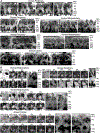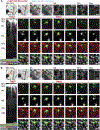Müller glial cells contribute to dim light vision in the spectacled caiman (Caiman crocodilus fuscus): Analysis of retinal light transmission
- PMID: 29763583
- PMCID: PMC9930533
- DOI: 10.1016/j.exer.2018.05.009
Müller glial cells contribute to dim light vision in the spectacled caiman (Caiman crocodilus fuscus): Analysis of retinal light transmission
Abstract
In this study, we show the capability of Müller glial cells to transport light through the inverted retina of reptiles, specifically the retina of the spectacled caimans. Thus, confirming that Müller cells of lower vertebrates also improve retinal light transmission. Confocal imaging of freshly isolated retinal wholemounts, that preserved the refractive index landscape of the tissue, indicated that the retina of the spectacled caiman is adapted for vision under dim light conditions. For light transmission experiments, we used a setup with two axially aligned objectives imaging the retina from both sides to project the light onto the inner (vitreal) surface and to detect the transmitted light behind the retina at the receptor layer. Simultaneously, a confocal microscope obtained images of the Müller cells embedded within the vital tissue. Projections of light onto several representative Müller cell trunks within the inner plexiform layer, i.e. (i) trunks with a straight orientation, (ii) trunks which are formed by the inner processes and (iii) trunks which get split into inner processes, were associated with increases in the intensity of the transmitted light. Projections of light onto the periphery of the Müller cell endfeet resulted in a lower intensity of transmitted light. In this way, retinal glial (Müller) cells support dim light vision by improving the signal-to-noise ratio which increases the sensitivity to light. The field of illuminated photoreceptors mainly include rods reflecting the rod dominance of the of tissue. A subpopulation of Müller cells with downstreaming cone cells led to a high-intensity illumination of the cones, while the surrounding rods were illuminated by light of lower intensity. Therefore, Müller cells that lie in front of cones may adapt the intensity of the transmitted light to the different sensitivities of cones and rods, presumably allowing a simultaneous vision with both receptor types under dim light conditions.
Keywords: Caiman; Glia; Light guidance; Müller cell; Retina.
Copyright © 2018 Elsevier Ltd. All rights reserved.
Conflict of interest statement
Conflicts of interest
None of the authors have any financial and personal relationships with other people or organizations that could inappropriately influence (bias) their work.
Figures










References
-
- Abelsdorff G, 1898. Physiologische Beobachtungen am Auge der Krokodile. Arch Anat Physiol Physiol Abt 155–167.
-
- Barer R, 1957. Refractometry and interferometry of living cells. J Opt Soc Am A Opt Image Sci Vis 47, 545–556. - PubMed
-
- Beuthan J, Minet O, Helfmann J, Herrig M, Müller G, 1996. The spatial variation of the refractive index in biological cells. Phys. Med. Biol. 41, 369–382. - PubMed
Publication types
MeSH terms
Substances
Grants and funding
LinkOut - more resources
Full Text Sources
Other Literature Sources

